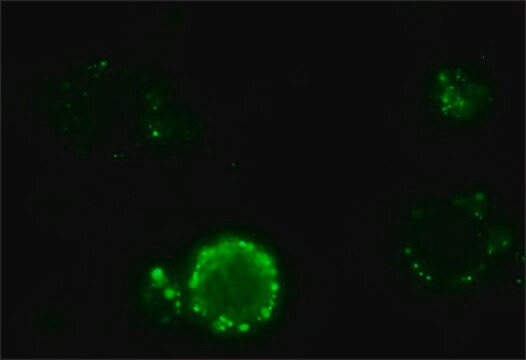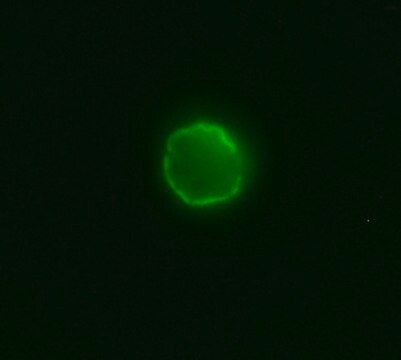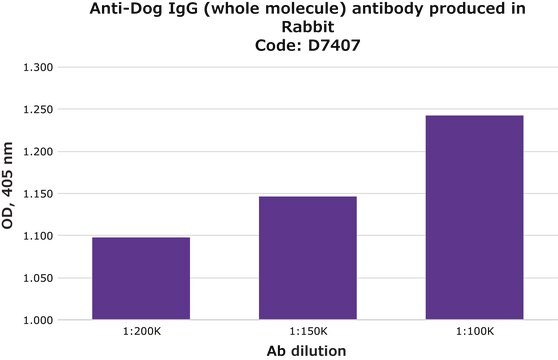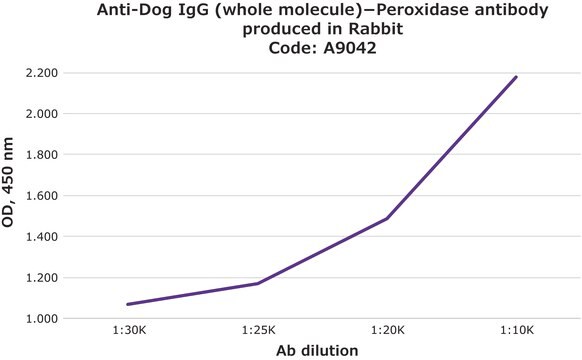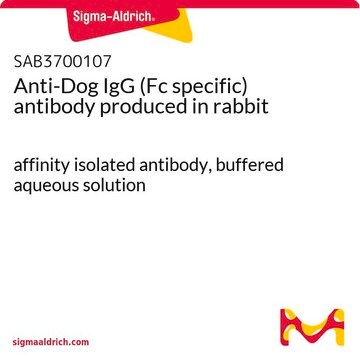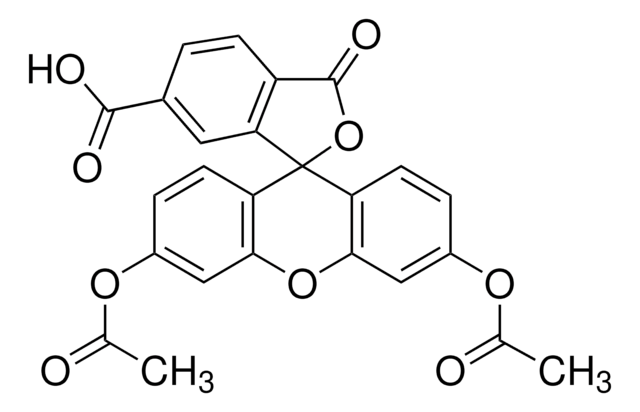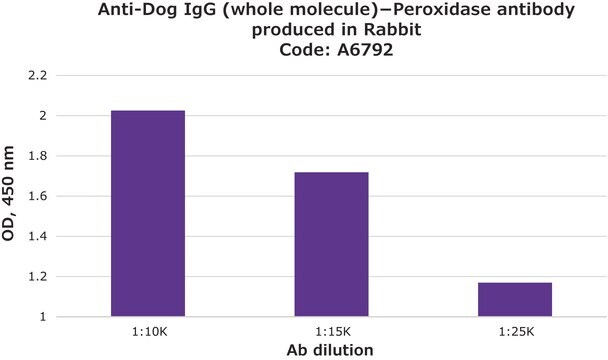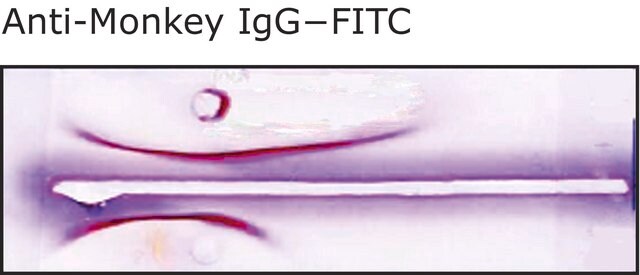F7884
Anti-Dog IgG (whole molecule)–FITC antibody produced in rabbit
affinity isolated antibody, buffered aqueous solution
Synonym(s):
Rabbit Anti-Dog IgG (whole molecule)–Fluorescein isothiocyanate
Sign Into View Organizational & Contract Pricing
All Photos(1)
About This Item
Recommended Products
biological source
rabbit
Quality Level
conjugate
FITC conjugate
antibody form
affinity isolated antibody
antibody product type
secondary antibodies
clone
polyclonal
form
buffered aqueous solution
storage condition
protect from light
technique(s)
direct immunofluorescence: 1:32
storage temp.
−20°C
target post-translational modification
unmodified
Looking for similar products? Visit Product Comparison Guide
General description
IgG (Immunoglobulin G) antibody subtype is the most abundant serum immunoglobulins of the immune system. It is secreted by B cells and is found in blood and extracellular fluids and provides protection from infections caused by bacteria, fungi and viruses. Rabbit anti-dog IgG is isolated by affinity isolation and conjugated to Fluorescein Isothiocyanate (FITC).
The variable region of IgG antibody is specific to antigens and is highly conserved. IgG has four subclasses- IgG1, IgG2a, IgG2b and IgG2c.
The variable region of IgG antibody is specific to antigens and is highly conserved. IgG has four subclasses- IgG1, IgG2a, IgG2b and IgG2c.
Specificity
Anti-Dog IgG (whole molecule)-FITC antibody is specific for dog IgG subclasses.
Immunogen
Purified dog IgG
Application
Anti-Dog IgG (whole molecule)-FITC antibody may be used for direct immunofluorescence using dog peripheral blood lymphocytes at a minimum working dilution of 1:32.
Biochem/physiol Actions
IgG (Immunoglobulin G) antibody provides protection from infections caused by bacteria, fungi and viruses. Maternal IgG is transferred to fetus through the placenta that is vital for immune defense of the neonate against infections. IgG antibody has its function similar to IgM antibody in complement system activation. IgG participates in hypersensitivity type II and type III. It helps in opsonization, complement fixation and antibody dependent cell mediated cytotoxicity.
Physical form
Solution in 0.01 M phosphate buffered saline, pH 7.4, containing 1% bovine serum albumin and 15 mM sodium azide.
Storage and Stability
For continuous use, store at 2-8 °C for up to one month.
For extended storage, the solution may be frozen in working aliquots. Repeated freezing and thawing, or storage in "frost-free" freezers, is not recommended. If slight turbidity occurs upon prolonged storage, clarify the solution by centrifugation before use.
For extended storage, the solution may be frozen in working aliquots. Repeated freezing and thawing, or storage in "frost-free" freezers, is not recommended. If slight turbidity occurs upon prolonged storage, clarify the solution by centrifugation before use.
Disclaimer
Unless otherwise stated in our catalog or other company documentation accompanying the product(s), our products are intended for research use only and are not to be used for any other purpose, which includes but is not limited to, unauthorized commercial uses, in vitro diagnostic uses, ex vivo or in vivo therapeutic uses or any type of consumption or application to humans or animals.
Not finding the right product?
Try our Product Selector Tool.
Storage Class Code
10 - Combustible liquids
WGK
nwg
Flash Point(F)
Not applicable
Flash Point(C)
Not applicable
Personal Protective Equipment
dust mask type N95 (US), Eyeshields, Gloves
Choose from one of the most recent versions:
Already Own This Product?
Find documentation for the products that you have recently purchased in the Document Library.
Customers Also Viewed
Federica Riccardo et al.
Clinical cancer research : an official journal of the American Association for Cancer Research, 20(14), 3753-3762 (2014-05-31)
Due to the many similarities with its human counterpart, canine malignant melanoma (cMM) is a valuable model in which to assess the efficacy of novel therapeutic strategies. The model is herein used to evaluate the immunogenicity, safety, and therapeutic efficacy
Vanessa Figueredo Pereira et al.
Revista da Sociedade Brasileira de Medicina Tropical, 49(1), 104-106 (2016-05-11)
Conjunctival swab PCR was evaluated as a tool to diagnose visceral leishmaniasis in dogs. Conjunctival swab PCR was compared to indirect immunofluorescence antibody test and blood PCR. Indirect immunofluorescence was significantly correlated with conjunctival swab PCR (p < 0.05), but
Hanna D Bremer et al.
Scientific reports, 8(1), 4852-4852 (2018-03-21)
Dogs can spontaneously develop complex systemic autoimmune disorders, with similarities to human autoimmune disease. Autoantibodies directed at self-antigens are a key feature of these autoimmune diseases. Here we report the identification of interleukin enhancer-binding factors 2 and 3 (ILF2 and
Suckow M A, et al.
The Laboratory Rat, 205(3-4) (2014)
P R Romanelli et al.
Research in veterinary science, 82(2), 202-207 (2007-02-03)
Sheep and dog blood samples were collected from nine farms in the county of Guarapuava, Paraná, Brazil. The indirect fluorescent antibody test (IFAT) was used to detect Neospora caninum and Toxoplasma gondii antibodies. Herein, serum samples from 305 sheep were
Our team of scientists has experience in all areas of research including Life Science, Material Science, Chemical Synthesis, Chromatography, Analytical and many others.
Contact Technical Service